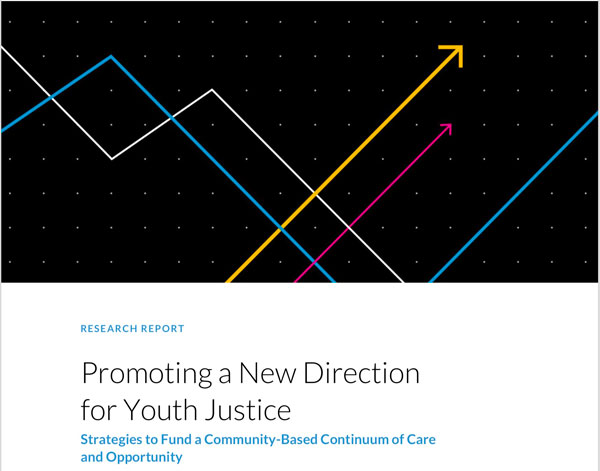
March 27, 2019; Colorlines
The issue of juvenile justice is gaining more attention nationally, and for good reason. Even as youth incarceration has declined by 50 percent since 2003, these declines have exacerbated racial disparities. According to the Haywood Burns Institute, when compared to white youth, black youth are five times, Native American youth are 3.2 times, and Latinx youth are twice as likely to be incarcerated—and in some states, this disparity is even higher. On any given day, 53,000 youth are incarcerated within the juvenile justice system, with one in five being “detained” awaiting a hearing, sentence, or placement. And the cost is astronomical. According to the American Civil Liberties Union (ACLU), the average cost of incarcerating a juvenile for one year is between $35,000 to $64,000, depending on the state. In contrast, the cost of Head Start ranges by state between roughly $7,000 and $11,000 a year. The dynamics of profiting off of incarcerating youth are also concerning, as discussed previously in NPQ.
In addition to the costs, both human and monetary, under the current system there are long-term consequences for youth. These include worse physical and mental health outcomes, lower educational attainment, and increased likelihood of incarceration as an adult. It is with this backdrop that a new report was released this week from the Urban Institute in partnership with Youth First Initiative, a nonprofit dedicated defining warfare safe and economically sound alternatives to youth presents. The report, Promoting a New Direction for Youth Justice: Strategies to Fund a Community-Based Continuum of Care and Opportunity—authored by Samantha Harvell, Chloe Warnberg, Leah Sakala, and Constance Hall—focuses on fostering a community-based continuum of care as a comprehensive juvenile justice reform strategy by orienting systems to function in ways that support long-term well-being of young people.
The report is broad in scope and looks at strategies for community-based care as well as funding mechanisms that can be leveraged to institute such a system. The Urban Institute compiled the report based on the following methods, drawn from a cross section of stakeholders:
Sign up for our free newsletters
Subscribe to NPQ's newsletters to have our top stories delivered directly to your inbox.
By signing up, you agree to our privacy policy and terms of use, and to receive messages from NPQ and our partners.
- Interviews with more than 20 advocates government agency officials, legislators, representatives from community organizations, and other stakeholders with expertise on state budget systems, justice reinvestment, community investment, and juvenile justice conducted between June and October 2018;
- a convening on Innovative Strategies for Reinvesting in Youth Justice with approximately 40 advocates, practitioners, and budget experts in Washington, DC, in August 2018;
- two roundtables with approximately 25 youth advocates (including teenagers, young adults, and staff) in Milwaukee, WI and Richmond, VA, on “Making Smarter Investments in Juvenile Justice” in November and December 2018; and
- A review of relevant program materials, research, and reports of identified programs, examples, and strategies.
The central tenet of the report looks at creating a continuum of community-based care and opportunity for young people, as a viable alternative to the current juvenile justice system. This means non-residential programs, support, resources, or services that both young people and families can access while living in their homes. In their report, Howell and her coauthors contend that a truly comprehensive juvenile justice system would need to include:
- access to health care, including mental health treatment
- civic engagement and service-learning opportunities
- crisis services, including mobile units
- early care and education
- economic development and community infrastructure
- educational and vocational support and programming, apprenticeships, etc.
- family therapy
- holistic victims’ services
- life skills programs
- mentoring programs
- parenting programs
- pathways for future economic opportunity and job opportunities that provide a living wage
- positive youth development programming, including school-based programs
- programs that support basic needs including safe and affordable housing, adequate nutrition, and reliable transportation
- prosocial enrichment and recreational opportunities (e.g. sports, art, music, theater, etc.)
- respite and support for families with complex needs
- restorative justice programming
- substance use treatment
- thriving community centers and safe spaces for recreation
- trauma recovery and healing programming and supports
- violence prevention and gang intervention programs
By integrating services, this model addresses multiple needs simultaneously by ensuring that services are culturally appropriate, effective, and responsive to the evolving needs of youth and families.
Howell and her team also identify four specific strategies to begin implementation, namely:
- capturing and reinvesting savings from reduced youth incarceration and facility closure
- repurposing former incarceration facilities and leveraging land value
- leveraging existing state and federal funding streams (child welfare funding, workforce and education grants, Victims of Crime Act funding, and Community Development Block Grants)
- thinking outside the box to redirect existing resources or generate new funds to support a continuum of care and opportunity for youth and families (Pay for Success models, Participatory Budgeting, Opportunity Zones, Anchor Institutions)
In addition to a broad vision, funding mechanisms, and specific strategies, the report discusses case studies, including California’s Youth Reinvestment Grant Program. NPQ discussed California’s juvenile justice opportunity on Monday in “Can California Adjust to Good News and Shift Spending from Jails to Schools?”
Overall, Harvell and her coauthors offer a compelling vision for a community-based continuum of care. Considering the poor long-term outcomes of youth that have been incarcerated, it is vital that policy makers, as well as youth serving nonprofits, understand community-based solutions, and engage in thoughtful dialogues about ways to address the existing disparities.—Derrick Rhayn













